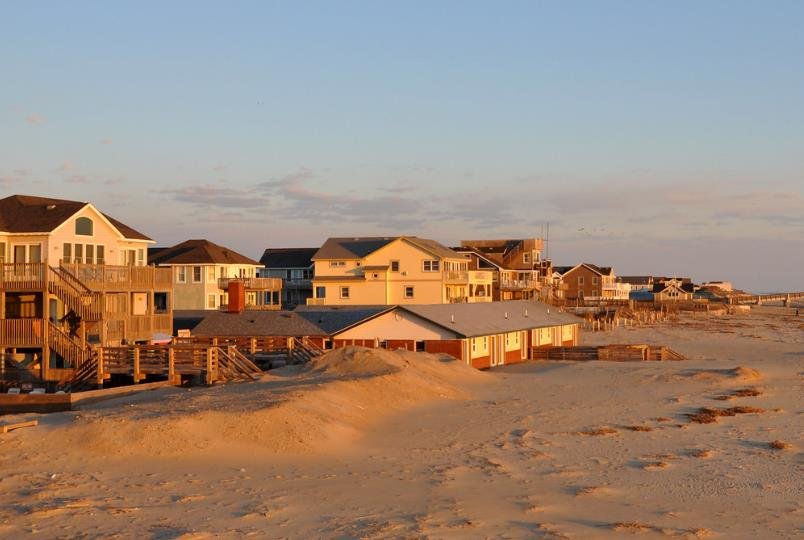A relentless coastal storm caused another home to vanish into the turbulent waters off North Carolina’s Outer Banks, marking the sixth collapse in Rodanthe this year alone.
Last night, a severe storm swept through Rodanthe, Dare County, unleashing powerful winds and towering waves that ultimately led to the collapse of an unoccupied home into the ocean. The National Park Service confirmed the incident, emphasizing that no injuries were reported since the home was vacant at the time of the collapse.
“This is a stark reminder of the powerful forces at play along our coastline,” stated a spokesperson from the Cape Hatteras National Seashore. “Our priority is ensuring public safety and monitoring vulnerable structures.”
Highway Closures and Safety Warnings
In the aftermath of the collapse, portions of Highway 12 near Rodanthe were temporarily shut down to facilitate cleanup and assess the damage. The beach area in front of the collapsed property remains closed due to hazardous debris, with officials urging residents and visitors to avoid the vicinity and the ocean areas extending several miles south of Rodanthe.
Safety Measures Implemented:
- Temporary Road Closures: Highway 12 remains closed near the collapse site.
- Debris Management: Removal of dangerous materials from the beachfront.
- Public Advisories: Continuous warnings to stay away from affected areas.
Flint City Administrator Clyde Edwards emphasized the urgency of addressing these issues, warning that further inaction could lead to more severe financial hardships for the city and jeopardize essential services.

A Pattern of Destruction: Six Collapses Since May
The recent collapse is the sixth in Rodanthe since May, each event highlighting the escalating impact of severe weather and rising sea levels on coastal communities. Here’s a timeline of the previous incidents:
Table: Home Collapses in Rodanthe, 2024
| Date | Time | Status |
|---|---|---|
| May 28 | 2:30 a.m. | Unoccupied |
| Aug. 16 | 6:50 p.m. | Unoccupied |
| Sept. 20 | Early morning | Unoccupied |
| Sept. 20 | Early morning | Unoccupied |
| Sept. 24 | Afternoon | Unoccupied |
| Nov. 14-15 | Overnight | Unoccupied |
“These repeated collapses are alarming,” said Maria Lopez, a local business owner. “It’s not just about the structures themselves but the overall safety and stability of our community.”
The Role of Severe Weather and Climate Change
Experts agree that the increasing frequency of severe storms and the ongoing rise in sea levels are primary contributors to the structural failures observed in Rodanthe. The National Weather Service had forecasted wind gusts reaching up to 50 mph along the Outer Banks, coupled with warnings of ocean overwash, which have proven devastating.
- Intense Storms: Powerful wind gusts and high waves exert immense pressure on coastal structures.
- Rising Sea Levels: Persistent encroachment of seawater undermines foundations.
- Erosion: Gradual loss of land exacerbates the vulnerability of remaining structures.
Dr. Elena Martinez, a climate scientist, explained, “The Outer Banks are on the front lines of climate change. Each storm not only tests our resilience but also our preparedness to safeguard our communities against natural disasters.”
Community Response and Future Precautions
In response to the ongoing threat, local authorities and community leaders are ramping up efforts to enhance resilience and prevent future collapses. This includes stricter building codes, enhanced emergency preparedness, and increased funding for coastal defenses.
Community Initiatives:
- Stricter Building Codes: Implementing more robust construction standards to withstand severe weather.
- Emergency Preparedness Programs: Educating residents on safety protocols during storms.
- Coastal Defense Projects: Investing in seawalls and other infrastructure to protect against erosion and overwash.
“We’re taking proactive steps to protect our community,” said Tom Reynolds, a member of the Rodanthe Town Council. “It’s crucial that we work together to implement these measures and ensure the safety of our residents and visitors.”
Economic Impact on Rodanthe
The frequent home collapses have significant economic implications for Rodanthe. Property values are declining as potential buyers grow wary of the risks associated with living in such a vulnerable area. Additionally, the costs associated with repairing and reinforcing existing structures are mounting, straining the local economy.
Economic Challenges:
- Decreased Property Values: Rising concerns about safety lead to lower demand for coastal properties.
- Increased Repair Costs: Ongoing maintenance and reinforcement of structures are becoming financially burdensome.
- Tourism Impact: Negative perceptions may deter tourists, affecting local businesses reliant on seasonal visitors.
Local business owner Maria Lopez noted, “Our community thrives on tourism, and these incidents are making it harder to attract visitors. It’s a tough cycle that needs to be broken with effective solutions.”
Looking Ahead: Strategies for Sustainability
To combat these challenges, Rodanthe is exploring various strategies aimed at long-term sustainability and resilience. These include investing in renewable energy sources, enhancing natural barriers like wetlands, and fostering community-led initiatives to bolster local defenses against future storms.
Future Strategies:
- Renewable Energy Investments: Reducing reliance on vulnerable infrastructure by embracing sustainable energy solutions.
- Natural Barrier Enhancement: Restoring wetlands and dunes to provide natural protection against storm surges.
- Community-Led Defense Initiatives: Empowering residents to take part in local defense and resilience projects.
“These strategies are essential for ensuring that Rodanthe can withstand future storms and continue to thrive as a community,” stated Sarah Cawrse, the executive director of the River North Arts District.
Voices from the Community
The repeated collapses have left a mark on the residents, with many expressing a mix of frustration and determination to see change. While some advocate for immediate structural reinforcements, others push for more comprehensive approaches to address the underlying issues of climate change and urban planning.
Community Sentiments:
- Frustration: “It feels like we’re fighting an uphill battle against nature,” shared John Mitchell, a long-time resident.
- Determination: “We need to take decisive action now to protect our homes and our future,” added Sarah Collins, a local teacher.
- Hope: “There’s still a lot we can do to make Rodanthe safer and more resilient,” remarked Emily Harris, a community organizer.
As Rodanthe faces the harsh realities of climate change and severe weather, the community’s response will be crucial in determining its future resilience. With the sixth home collapse serving as a stark indicator, immediate and sustained efforts are necessary to safeguard this beloved coastal area from further devastation.








